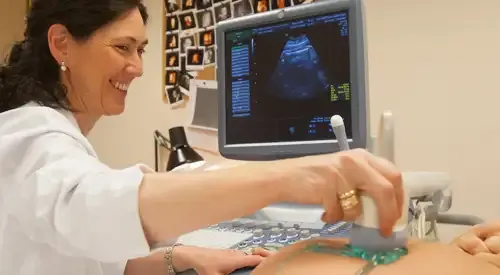Down's Syndrome
"Early stimulation programs are very conducive to the development of these children".
DR. ROCÍO SÁNCHEZ-CARPINTERO
DIRECTOR. NEUROPEDIATRICS UNIT

What is Down syndrome?
Down syndrome is a chromosomal abnormality, responsible for morphological and behavioral characteristics of affected subjects.
This syndrome has the name of the scientist who described it in 1866, Langson Down. Professor Jérome Lejeune, in 1959, first demonstrated the presence of a supplementary chromosome in these people, giving rise to the other name of Down syndrome: trisomy 21 (for three chromosomes 21).
The relationship between the presence of an extra chromosome and the signs of Down syndrome are not known exactly, and not surprisingly because each chromosome contains thousands of genes, which encode very different information.
However, several points seem clear: excess genetic material affects the production of proteins and regulation of other genes. Therefore the balance for the correct construction of the organism can be broken.
In addition, there is thus a possibility that excess substances are formed which in the long run can be harmful to the functioning of the organism.

What are the signs and symptoms of Down syndrome?
In the features of the face and body appearance:
- The slits of the eyes oblique.
- The base of the nose flattened.
- A fold in the inner corner of the eye.
- A short size.
- A single fold in the palm of the hand, which crosses the entire palm, hands and short fingers.
- The big tongue and thrown a little out of the mouth, which is small.
- The small ears.
- The short neck.
- The base of the skull flattened.
In the aspect of the motor system: the child is excessively soft, with increased passivity and elasticity.
In the aspect of the psychomotor development: there is a delay in the development of language, both in what the child understands and in what he expresses, of the adaptive behavior and the motor development.
In the internal organs some anomalies occur more frequently. This does not mean, logically, that each individual has all these complications:
- Heart malformations.
- Gastrointestinal malformations.
- Repeat infections.
- Obstructive sleep apneas.
Abnormalities in the functioning of the thyroid gland.
In the vision: myopia, hypermetropia and cataracts.
At the level of the nervous system, possibility of epilepsy and high frequency of early aging.
Does your child have Down syndrome?
You can benefit from an early stimulation program
How is Down syndrome diagnosed?

During pregnancy:
In the mother's blood the level of alpha-fetoprotein is low in case of trisomy 21, but it does not ensure the diagnosis. Ultrasound of the fetus can provide guidance, but does not guarantee the diagnosis.
Chorionic biopsy is performed at week 9-10. Amniocentesis consists of removing amniotic fluid (by transabdominal puncture) in the 15th week of pregnancy, and confirms the diagnosis with certainty.
After birth:
If the diagnosis is not known at birth, the features of the face, the excessive softness, and the high-pitched, choppy crying usually attract attention.
The definitive diagnosis is given by the study of the child's chromosomes (karyotype). Sometimes, it is necessary to make a study of the parents.
How is Down syndrome treated?
The experience of the last years confirms that these children benefit from early stimulation programs, carried out by a multidisciplinary team (pediatrician, neuropediatrician, psychologists, psychopedagogues, etc.) with active participation of the family.
School integration constitutes an important resource for their development and social adaptation. One of the goals is training for personal care.
Education is also aimed at ensuring that, as an adult, this person knows how to exercise his/her freedom, with responsibility, respecting others; with emotional stability and affective compensation; with useful and productive work activity, although not always economically profitable.
Where do we treat it?
IN NAVARRA AND MADRID
The Department of Pediatrics
of the Clínica Universidad de Navarra
All our specialists work exclusively and, in addition, since we have all the technology in the same center, we offer the performance of tests and diagnosis in less than 72 hours.
We have a team of highly qualified professionals to attend the different specialized units: Oncopediatrics, Neuropediatrics, Endocrinopediatrics, Neonatology, etc.
Organized in specialized units
- Neonatology Area.
- Pediatric Endocrinology.
- Pediatric Cardiology.
- Pediatric Neuropediatrics.
- Digestive and pediatric nutrition.
- General and preventive pediatrics.
- Pediatric Pneumology.

Why at the Clinica?
- Comprehensive care of the child.
- Professionals who are experts in the different areas for a better diagnosis and treatment.
- Equipped with the latest technology for newborn care.


























